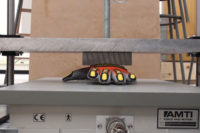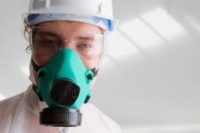 May 14, 2012
May 14, 2012
Mr. Matthew McCullough
The Green Insulation Company, LLC
9 Palmer Street
Stamford, CT 06907
Dear Mr. McCullough:
Thank you for your October 21, 2011, letter to the Occupational Safety and Health Administration (OSHA). Your letter was referred to the Directorate of Enforcement Programs for a response. You requested an interpretation of OSHA's Respiratory Protection standard, 29 CFR 1910.134, specifically concerning the general requirements at §1910.134(d)(l)(iii), regarding identifying and evaluating the respiratory hazard(s) in the workplace. This letter constitutes OSHA's interpretation only of the requirements discussed and may not be applicable to issues not delineated within your original correspondence. Your paraphrased question and our response are below:
Does an employer have to conduct air testing to evaluate respiratory hazards?
Scenario: When installing spray foam insulation in a commercial building you are using multiple negative air machines to control worker exposures to methylene bisphenyl isocyanate (MDI). Your letter summarized how you evaluated the respiratory hazards in the work area, and you require your installers to wear full face air purifying respirators in the work area. Your evaluation was based on a copy of the manufacturer's material safety data sheet (MSDS) for the foam insulation, as well as a re-occupancy guideline from a manufacturer of foam insulation.
Question: To comply with §1910.134(d)(l)(iii) of OSHA's Respiratory Protection standard, would it be necessary to conduct air testing to evaluate respiratory hazards from the MDI during the application of the foam since the workers are already being required to wear full-face air-purifying respirators?
Response: Not necessarily. OSHA's Respiratory Protection standard at §1910.134(d)(l)(iii) states, "The employer shall identify and evaluate the respiratory hazard(s) in the workplace; this evaluation shall include a reasonable estimate of employee exposures to respiratory hazard(s) and an identification of the contaminant's chemical state and physical form." Although the most reliable and accurate method to determine exposure is to conduct personal air monitoring, it is not explicitly required by the Respiratory Protection standard. Instead, other means can be used to estimate workplace exposures. These methods include, but are not limited to, the use of objective data, application of mathematical approaches, and others. Additional information regarding hazard evaluation can be found at CPL 02-00-120, Inspection Procedures for the Respiratory Protection Standard, paragraph E. When using any of these methods, the data needs to be accurate and representative of conditions at the current work site, including materials being applied and work being performed. In addition, the assessment would also need to consider exposures to any other hazardous chemicals in the foam-application process.
The re-occupancy study that you provided should not be considered a representative estimate of your workers' exposures to MDI during the application of spray foam insulation. The study was a proposed method for determining the delay required before safely reoccupying a building following application of spray-foam insulation. The study did not provide any exposure data for workers' exposures to MDI or other chemicals during application of spray-foam insulation. Thus, this data would not satisfy the requirement at 1910.134(d)(l)(iii) for selection of appropriate respiratory protection.
In conclusion, a reasonable estimate of employee exposure would need to include data that closely resembles your work operation and expected chemical exposures. As stated above, the most accurate and reliable data is obtained by conducting personal air monitoring of your actual operation.
You should be aware that 27 states, including Connecticut, administer their own OSHA-approved occupational safety and health programs, or State Plans. All State Plans are required to cover public sector (state and local government) employees (29 U.S.C. 667(c)(6)), and 22 State Plans also cover the private sector. These State Plans must adopt and enforce standards that are at least as effective as those standards promulgated by Federal OSHA (29 U.S.C. 667(c)(2)).
Additionally, if you are interested, all of the states administer a consultation service. The consultation programs are available to help employers identify potential hazards in their work places and provide means to assess and abate the hazard, including air sampling. The service is free of charge for small employers and any results or recommendations are not provided to OSHA. The Connecticut consultation service may be reached at:
Division of Occupational Safety and Health, Department of Labor
38 Wolcott Hill Road
Wethersfield, CT 06109
(860)263-6900
Website: http://www.ctdol.state.ct.us/osha/consult.htm
Thank you for your interest in occupational safety and health. We hope you find this information helpful. OSHA requirements are set by statute, standards, and regulations. Our interpretation letters explain these requirements and how they apply to particular circumstances, but they cannot create additional employer obligations. This letter constitutes OSHA's interpretation of the requirements discussed. Note that our enforcement guidance may be affected by changes to OSHA rules. Also, from time to time we update our guidance in response to new information. To keep apprised of such developments, you can continue to consult OSHA's Web site at www.osha.gov. If you have any further questions, please feel free to contact the Office of Health Enforcement at 202-693-2190.
Sincerely,
Thomas Galassi, Director
Directorate of Enforcement Programs



